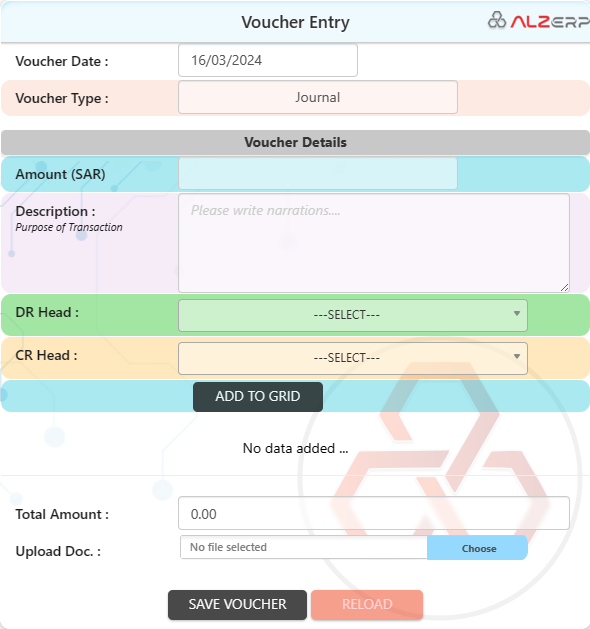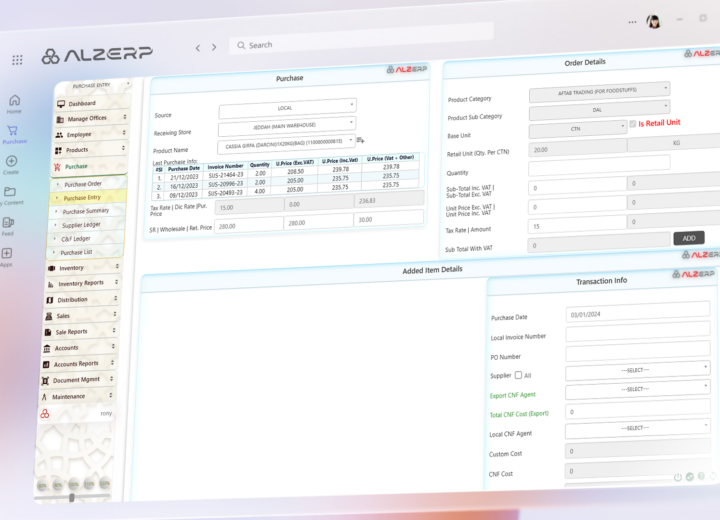Seasoned professionals know the abbreviations of ERP systems like it’s a second language. But, if you find yourself confused when reading stock reports, human resources, administrations, balance sheets or income statements, there are common terminology used in ALZERP Cloud ERP software. Keep reading for a list of abbreviations that will clear up any misunderstandings.
General Abreviations:
- A/c – Accounts or Accounting
- A/R – Accounts Receivable
- A/P – Accounts Payable
- COGS – Cost of Goods Sold
- EBITDA – Earnings Before Interest, Taxes, Depreciation, and Amortization
- GAAP – Generally Accepted Accounting Principles
- GRN – Goods Received Note
- FIFO – First In, First Out
- LIFO – Last In, First Out
- ROI – Return on Investment
- P&L – Profit and Loss
- CPA – Certified Public Accountant
- IRS – Internal Revenue Service
- VAT – Value Added Tax
- CFO – Chief Financial Officer
- SEC – Securities and Exchange Commission
- EPS – Earnings Per Share
- ROA – Return on Assets
- ROE – Return on Equity
- APIC – Additional Paid-In Capital
- EFT – Electronic Funds Transfer
- ERP – Enterprise Resource Planning
- CRM – Customer Relationship Management
- SCM – Supply Chain Management
- HRM – Human Resource Management
- BI – Business Intelligence
- WMS – Warehouse Management System
- MRP – Material Requirements Planning
- PLM – Product Lifecycle Management
- BOM – Bill of Materials
- SOP – Sales and Operations Planning
- MRP – Manufacturing Resource Planning
- EAM – Enterprise Asset Management
- EDI – Electronic Data Interchange
- POS – Point of Sale
- FIFO – First In, First Out
- LIFO – Last In, First Out
- WIP – Work In Progress
- BPR – Business Process Reengineering
- KPI – Key Performance Indicator
- B2B – Business-to-Business
- B2C – Business-to-Consumer
- API – Application Programming Interface
- GUI – Graphical User Interface
- SQL – Structured Query Language
- OLAP – Online Analytical Processing
- ARPU – Average Revenue Per User

Administrative Abreviations
- CFO: Chief Financial Officer – The highest-ranking executive responsible for a company’s financial activities.
- CPA: Certified Public Accountant – A professional accountant with a specific license to provide financial auditing and tax services.
- Dr.: Debit – As explained above, a debit typically increases expense or liability accounts and decreases asset accounts.
- Cr.: Credit – As explained above, a credit typically increases asset accounts and decreases expense or liability accounts.
- EBITDA: Earnings Before Interest, Taxes, Depreciation, and Amortization – A metric used to assess a company’s profitability from its core operations.
- EOY: End of Year – The last day of a company’s fiscal year.
- GAAP: Generally Accepted Accounting Principles – The set of accounting standards and procedures companies must follow when preparing financial statements.
- GST: Goods and Services Tax (may vary depending on location) – A value-added tax (VAT) applied to goods and services.
- HVAC: Heating, Ventilation, and Air Conditioning – Often a significant expense for businesses.
- IRR: Internal Rate of Return – A metric used to evaluate the profitability of potential investments.
- LIFO: Last-In, First-Out (inventory valuation method) – Assumes the most recently purchased items are sold first.
- FIFO: First-In, First-Out (inventory valuation method) – Assumes the oldest items in inventory are sold first.
- NA: Not Applicable – Used when a particular information is not relevant.
- NPV: Net Present Value – A metric used to assess the profitability of an investment by considering the time value of money.
- ROE: Return on Equity – A profitability ratio that measures the return on investment for shareholders.
- ROI: Return on Investment – A metric used to assess the efficiency of an investment or project.
- SOS: Statement of Stockholders’ Equity – A financial statement that shows the changes in a company’s equity over a period.
- WIP: Work in Progress – Inventory that is partially completed and not yet ready for sale.
- CRM: Customer Relationship Management – Software that helps manage customer interactions and relationships.
- ERP: Enterprise Resource Planning – Software that integrates various business functions like accounting, inventory, and customer service.
- SaaS: Software as a Service – Cloud-based software delivery model where users access applications over the internet.
- API (Application Programming Interface): A set of routines, protocols, and tools that allow different software programs to communicate with each other.
- CRM (Customer Relationship Management): Software that helps businesses track and manage interactions with customers and potential customers.
- EDI (Electronic Data Interchange): The direct transfer of data between computer systems without the need for paper forms.
- ERP (Enterprise Resource Planning): Software that integrates and manages many of a business’s core functions, such as accounting, inventory, human resources, and manufacturing.
- GL (General Ledger): The central accounting record that summarizes all financial transactions for a company.
- POS (Point of Sale): The place where a customer makes a payment for goods or services.
- WMS (Warehouse Management System): Software that helps businesses manage the movement and storage of goods in a warehouse.
- Accounting and Finance Abbreviations:
- A/P (Accounts Payable): The money a company owes to its suppliers for goods or services purchased on credit.
- A/R (Accounts Receivable): The money that customers owe a company for goods or services purchased on credit.
- COGS (Cost of Goods Sold): The direct cost of producing the goods sold by a business.
- FIFO (First In, First Out): An inventory costing method that assumes the first items purchased are the first items sold.
- LIFO (Last In, First Out): An inventory costing method that assumes the last items purchased are the first items sold.
- P&L (Profit and Loss): A financial statement that summarizes a company’s revenues and expenses during a specific period.
- Manufacturing Abbreviations:
- BOM (Bill of Materials): A list of the raw materials, parts, and subassemblies required to produce a finished product.
- MRP (Material Requirements Planning): A software system that helps businesses plan and manage the materials they need to produce goods.
- WIP (Work in Progress): Goods that are in the process of being manufactured but are not yet complete.
- Other Abbreviations:
- BI (Business Intelligence): Software and technologies that help businesses analyze their data and make better decisions.
- HCM (Human Capital Management): Software that helps businesses manage their human resources activities, such as payroll and benefits.
- SSO (Single Sign-On): A system that allows a user to log in once to access multiple applications.
- UI/UX (User Interface/User Experience): The way that users interact with a software program.
- SKU (Stock Keeping Unit): A unique identifier assigned to each product in your inventory.
- EOQ (Economic Order Quantity): The optimal amount of inventory to order at a time to minimize costs.
- ABC Analysis: A method for classifying inventory items based on their value and importance.
- FIFO (First-In, First-Out): An inventory costing method that assumes the first items purchased are the first ones sold.
- LIFO (Last-In, First-Out): An inventory costing method that assumes the last items purchased are the first ones sold.
- JIT (Just-In-Time): An inventory management strategy that minimizes the amount of inventory held by a company.
- MOQ (Minimum Order Quantity): The minimum quantity of a product that a supplier requires you to order.
- ROP (Reorder Point): The inventory level at which a new order should be placed.
- BOH (Beginning of Period): The amount of inventory on hand at the beginning of a specific period (e.g., month, year).
- EOH (End of Period): The amount of inventory on hand at the end of a specific period (e.g., month, year).
- POS (Point of Sale): The location where a product is sold to a customer.
Unit of Measure Abbreviations:
- PCS (Pieces): Individual units of a product.
- CTN (Carton): A box containing a specific number of individual units.
- DZ (Dozen): Twelve units of a product.
- LB (Pound): A unit of weight.
- KG (Kilogram): A unit of weight (metric system).
- FT (Foot): A unit of length.
- M (Meter): A unit of length (metric system).
- GAL (Gallon): A unit of volume.
- L (Liter): A unit of volume (metric system).
These abbreviations are commonly used in financial statements, and reports in ALZERP cloud ERP software.



